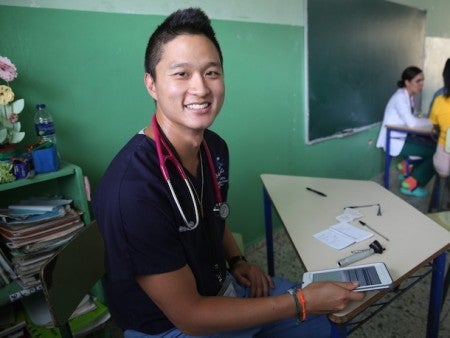UCF has made the trips for the past four years and developed a rudimentary electronic health record system about three years ago. But Kim, a healthcare IT specialist before enrolling in medical school, totally redesigned the system this summer. With his improvements, the records can reveal trends in the patient population, show whether and how patients improved over time, and make it easier for young medical students to track patients’ ailments and treatments. Using the system also helped students learn the electronic tools that are increasingly part of documenting quality care for physician reimbursements in an era of healthcare reform.
The Dominican Republic clinics were hardly a high-tech place to provide care. The team set up makeshift care sites in village schools. Electricity and running water were scarce. People waited in line for hours to get treatment for conditions from diabetes to parasites. The clinic had 100 people waiting the first day. Few patients spoke English. Many hadn’t seen a dentist ever or in years. In the makeshift clinic, UCF medical and nursing students and University of Florida pharmacy students worked with their faculty and community providers to triage patients and get them through various treatment stations, including internal medicine, OB-GYN and dental.
Electronic records that could be easily completed, searched and analyzed gave the healthcare providers needed information quickly. Just as important, the new system helped students see the progress of their patients – especially because so many were repeat visitors from a year ago.
“A couple of the patients I saw in internal med and pediatrics were actually repeating patients from last year and I can pull up records from last year. I can see what medications we gave them, see what they came in for last year,” said Kim after one day’s clinic where he saw patients and handled the IT network. “We can see what we did wrong or what we did well and really have a foundation for taking care of patients in terms of continuity of care.”
Before coming to medical school in 2014, Kim was a software designer at Epic, an electronic health record system. As the “IT guy,” Kim taught physicians how to use new technology, heard their complaints and often had to convince them that using electronic records were worth the effort. He said he took that feedback into consideration when he developed the UCF system.
He wanted the system to be easy to use, especially for young medical students who are also learning patient care techniques – and medical Spanish. For that reason, he included Spanish translations for each diagnosis so students who are all not fluent could pick up easier on what their patients were saying. He created fields that could be filled out using drop-down menus rather than requiring students to type out information at length. And he created key word search functions so future research can be done on patient trends.
“What I did was allow doctors to put information into the system and make those data points searchable so we can go back and look into the system and search all encounters and really search specifics, like certain number of diabetic patients or pediatric patients coming in with asthma,” said Kim.
Electronic health records are becoming essential tools for tracking health outcomes and best practices in patient care, especially as America’s healthcare system transitions to reimbursing doctors for the quality of their care rather than the number of patient visits. The use of such systems is in international medical mission trips is relatively new and Kim hopes to help UCF become a leader in using electronic records for research and improving the quality of care in underserved areas.
“UCF is at the forefront of this movement,” said Kim who hopes to share his new software with other universities.
Another goal of the electronic system is to better understand if the medical mission trips are improving the health of the impoverished population over time. Sustainability is a key issue for organizers, who want to be sure the medical mission trips provide tangible improvements for residents – not just a great learning experience for students.
“The patients report the education and care we provide are important.” said Dr. Judy Simms Cendan, assistant professor at the College of Medicine, director of global health initiatives, and the faculty member who lead the medical mission team. “We want to be able to track our patients’ health and understand how environmental and social issues are affecting their health. We also want to determine if our outreach programs are making a difference, and if so, in what way.
In the future the team hopes to also use the records to share information with the few local physicians near the villages and expand the type of care they provide by understanding the community’s health trends.
The Diebel Legacy Fund of Central Florida Foundation – a long-time supporter of the medical mission trip – donated $10,000 to fund travel scholarships for the medical students to encourage and support volunteer medical initiatives to help the underserved.
To see a video version of this story, visit https://youtu.be/coTi3FoDwSg
